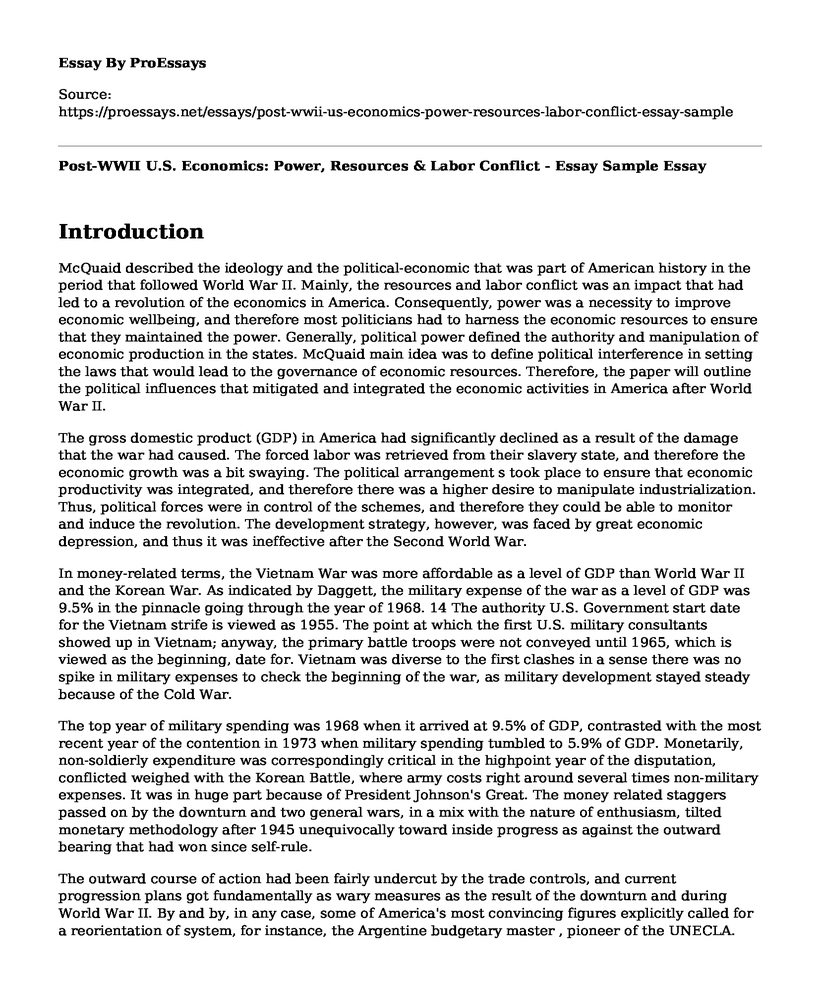Introduction
McQuaid described the ideology and the political-economic that was part of American history in the period that followed World War II. Mainly, the resources and labor conflict was an impact that had led to a revolution of the economics in America. Consequently, power was a necessity to improve economic wellbeing, and therefore most politicians had to harness the economic resources to ensure that they maintained the power. Generally, political power defined the authority and manipulation of economic production in the states. McQuaid main idea was to define political interference in setting the laws that would lead to the governance of economic resources. Therefore, the paper will outline the political influences that mitigated and integrated the economic activities in America after World War II.
The gross domestic product (GDP) in America had significantly declined as a result of the damage that the war had caused. The forced labor was retrieved from their slavery state, and therefore the economic growth was a bit swaying. The political arrangement s took place to ensure that economic productivity was integrated, and therefore there was a higher desire to manipulate industrialization. Thus, political forces were in control of the schemes, and therefore they could be able to monitor and induce the revolution. The development strategy, however, was faced by great economic depression, and thus it was ineffective after the Second World War.
In money-related terms, the Vietnam War was more affordable as a level of GDP than World War II and the Korean War. As indicated by Daggett, the military expense of the war as a level of GDP was 9.5% in the pinnacle going through the year of 1968. 14 The authority U.S. Government start date for the Vietnam strife is viewed as 1955. The point at which the first U.S. military consultants showed up in Vietnam; anyway, the primary battle troops were not conveyed until 1965, which is viewed as the beginning, date for. Vietnam was diverse to the first clashes in a sense there was no spike in military expenses to check the beginning of the war, as military development stayed steady because of the Cold War.
The top year of military spending was 1968 when it arrived at 9.5% of GDP, contrasted with the most recent year of the contention in 1973 when military spending tumbled to 5.9% of GDP. Monetarily, non-soldierly expenditure was correspondingly critical in the highpoint year of the disputation, conflicted weighed with the Korean Battle, where army costs right around several times non-military expenses. It was in huge part because of President Johnson's Great. The money related staggers passed on by the downturn and two general wars, in a mix with the nature of enthusiasm, tilted monetary methodology after 1945 unequivocally toward inside progress as against the outward bearing that had won since self-rule.
The outward course of action had been fairly undercut by the trade controls, and current progression plans got fundamentally as wary measures as the result of the downturn and during World War II. By and by, in any case, some of America's most convincing figures explicitly called for a reorientation of system, for instance, the Argentine budgetary master , pioneer of the UNECLA. Prebisch and his supporters requested that the terms of trade and enthusiasm for the contemporary world were stacked for the made mechanical nations of "within" as against the making nations of the "periphery." Their system, as such, recollected emphasis for money related upgrade and import substitution industrialization (ISI) for increasingly noticeable fiscal self-rule. They called for money related blend among the Latin American countries themselves, with the ultimate objective of achieving economies of scale. Furthermore, they recommended inside fundamental alterations to improve the economic introduction of their countries, comprising land change both to take out underutilized as well as to decrease the particular awkwardness of pay assignment that was a tangle to the advancement of the nearby market.
In the little Caribbean and Central American republics and besides a part of the more diminutive and less blessed South American nations, the opportunities for ISI were agonizingly confined by promoting size and various objectives, governments in spite of everything faltered to propel amassing to the burden of ordinary essential products. In any case, in countries speaking to a disproportionate part of Latin America's masses and (GDP), the new technique got full play through cautious duties, apportionments, and authoritarian tendencies. Overstated exchange rates, which hurt regular charges, made it more straightforward to import present-day equipment and apparatus. Collecting costs regularly remained high, and handling plants were exorbitantly dependent on imported commitments of various sorts, yet advances were not compelled to purchaser stock creation.
In every critical country the yield of widely appealing and capital product rose obviously too. For example, in Argentina the Nation endeavored advancement of a steel production, and from numerous perspectives state governments further broadened their fiscal activity. Brazil state-owned its primary oil production in 1953, enhancing the government firm Petrobras that over the long haul situated adjacent by PEMEX (1975) as one of Latin America's three most considerable money related undertakings, all state-run.
Bibliography
McQuaid, K. (1994). Uneasy partners: big business in American politics, 1945-1990. JHU Press. https://books.google.co.ke/books?hl=en&lr=&id=2SaLvkGOwokC&oi=fnd&pg=PR11&dq=American+history+in+year+1945+to+1990&ots=NnOT2rWhq0&sig=TItViK3EIHt8XFTlKisygHgGGVo&redir_esc=y#v=onepage&q=American%20history%20in%20year%201945%20to%201990&f=false
Cite this page
Post-WWII U.S. Economics: Power, Resources & Labor Conflict - Essay Sample. (2023, Jun 07). Retrieved from https://proessays.net/essays/post-wwii-us-economics-power-resources-labor-conflict-essay-sample
If you are the original author of this essay and no longer wish to have it published on the ProEssays website, please click below to request its removal:
- Essay Sample on Rochester and Western New York History
- Essay Example on American Civil War: Conflict that Shaped and Preserved the Nation
- Essay Example on Analyzing Community Challenges: A Necessity of Life
- Essay Example on Jean-Paul Sartre: The Best Philosopher of His Time and Beyond
- Essay Example on Ancient Civilizations: Comparing Customs and Social Behaviors
- Compare and Contrast Essay on Employee Benefits in Canada & US: A Perspective
- Rising Crime: A Result of Unemployment of Youth - Essay Sample







